What's in the box this week
~~~~~~~~~~~~~~~~~~~~~~~~~~~~~~~~~~~~~~~~~~~~~~~~
Content differences between Family and
Small shares are in red; items with a
"+" in Family Shares are more in quantity than in Small. For any items
not from our farm, we will identify the source in parentheses. Occasionally content will differ
from this list (typically we make a substitution), but we do our best to
give you an accurate projection.
Family Share
Sprouts 'salad' mix - sunflower, pea, buckwheat, broccoli and radish (New Natives) +
Fuji apples
Artichokes (Swanton Berry Farm) +
Red beets (with green tops)
Cabbage
Carrots
Rainbow chard
Collard
"rapini" (looks/tastes like broccoli raab)
Green garlic (bunched)
Red Russian kale
Leeks (loose) +
French breakfast radishes
Rutabagas +
Strawberries
Small Share
Sprouts 'salad' mix - sunflower, pea,
buckwheat, broccoli and radish (New Natives) +
Fuji apples
Artichokes (Swanton Berry Farm)
Red beets (with green tops)
Carrots
Collard
"rapini" (looks/tastes like broccoli raab)
Green garlic (bunched)
Red
Russian kale
Leeks (loose)
French breakfast radishes
Rutabagas
Strawberries
Bread Option
This week's bread will be whole wheat with flax seed
Extra Fruit and Fruit "Bounty" Options
Remember, these options don't begin until May or later.
|
Another Seasonal Dance begins...
~~~~~~~~~~~~~~~~~~~~~~~~~~~~~~~~~~~~~~~~~~~~~~~~ 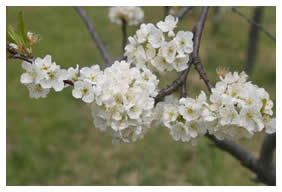 After a replenishing and wet winter the farm is wearing it's spring dress decorated with lush green cover crops, and flowering fruit trees, like a dancing partner, arms held out. We step into this welcoming embrace, committed to follow nature's lead, allowing the seasonal rhythm to guide us, anticipating the flavors and bountiful gifts yet to come. We are delighted to be welcoming you all to share with us, this, our 15th season of farming.
Your box of vegetables is more than just its content of earthly gifts. You have decided to participate in a seasonal relationship that is directly woven into the life of our land, its people, plants, animals, and soil. In this partnership we journey through the upcoming season sharing both the risk and bounty inherently involved in growing food.
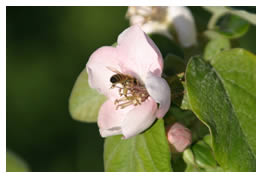
We invite you to see the farm as an extension of your own home or backyard garden, a place that offers the opportunity to step outside of today's 'instant' society and reconnect with the cyclical nature of growing, cooking and eating with the seasons.
I believe, as I have mentioned in previous newsletters, that we, as a community, are at a crossroads where our decisions will determine what kind of landscape our children will inherit and what kind of food they will be able to procure from that landscape. As CSA members we are pioneering a new vision of our future food landscape, making a conscious link between nutrition of our bodies to the health of the land.
We hope that you have the opportunity to visit the Farm and we welcome you to see and experience the land where your food comes from. - Tom
|
What's Up in the Fields
~~~~~~~~~~~~~~~~~~~~~~~~~~~~~~~~~~~~~~~~~~~~~~~~ The last three weeks of nice warm weather allowed us to plant, sow, mow, and watch the fruit trees bloom. Early red potatoes are planted, even the first squash seedlings are out, the beds for tomato plantings are prepared, 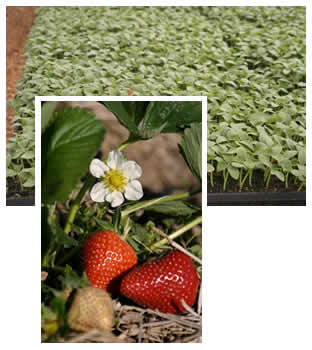 lots of little seedlings have been field transplanted, compost is being spread, strawberries are looking wonderful and everyone should have a small sampling in their first share. I hope this next storm system won't disrupt the pollination of the pear trees which are in full bloom, or slow down field preparations for many of the seedlings still waiting in the greenhouse to be planted. Although the heavy rains in early March prevented the apricots from setting a good crop of fruit, the plums seem to have an abundant set. We will wait until this storm system passes before sowing the first block of green beans, sugar snap peas, and garbanzo beans.
A few noteworthy additions to our list of crops I am very excited about: a small (quarter-acre) block of kiwis, an acre of asparagus - both the green and purple type, and as soon as the soil is ready we are also putting in a half-acre of green and red stemmed rhubarb. On the more exotic front, we are experimenting with a planting of cuttings of Nopales, a popular culinary cactus from Mexico.
Our family of farm animals also increased over the winter. In January, we adopted a small flock of sheep which birthed 11 beautiful baby lambs. All are currently grazing underneath the apricot orchard. Some of our mother goats gave birth early and their kids are happy exploring their new surroundings.
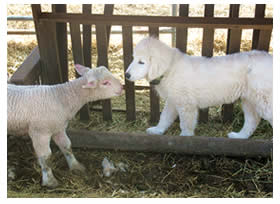 In order to prevent possible predator problems we have decided to raise a livestock guard dog. We got a puppy of a breed known as Maremma, which originated in Italy and is known to bond with livestock and protect them against predators (in our area, that would be coyotes and bobcats, maybe the occasional curious mountain lion). Her name is Chella, and she is only 16 weeks old. In the 4 weeks she's been here she's already very happy among her adopted family of wooly friends. Now we have to see if she will also bond with the chickens we are hoping to pasture and raise together with the sheep. Stay tuned, I'll keep you posted on how our new livestock herding adventures evolve over the course of the season.
Lastly I am very happy and excited to welcome a wonderful team of apprentices and farm journeymen this season. Both Molly Culver and Taylor Brady, apprentices last year, are continuing to deepen their experience and passion for farming this land. Taylor will continue her dual-position in both farming and the education programs. Molly is joined by her boyfriend, David Evershed, who completed two years at the UCSC's Agroecology Farming Program. Together Molly and David are committed to spending another couple seasons with us to pioneer and help develop a more formal farm journeyman's program for Live Earth Farm, before continuing to start a farm on their own. 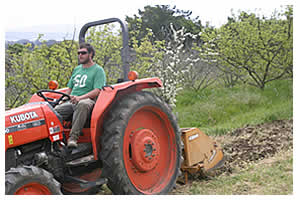 Our newest apprentice is Jeff Boesch, who will introduce himself through this newsletter soon (that's him, at right, pulling the spader behind the tractor). He also shows a great passion for farming and I am convinced will be a great addition to the team of Live Earth "Farmers".
|
Picking up in the rain
~~~~~~~~~~~~~~~~~~~~~~~~~~~~~~~~~~~~~~~~~~~~~~~~
The Binder: It looks as though our first CSA week is going to be a wet one, and so we would like to make a special request. Not all of our pick-up sites are protected from the elements, and so although the rain will not hurt your share, it can really do damage to the pick-up site binder that houses your checklist! If a binder sits out in the rain it will become sodden and unusable. To try to minimize this damage, in wet locations we will be putting the binder in a big ziploc bag. Please wipe it down best you can and place it back inside the bag after you've checked off next to your name. If you are the last person to pick up, please try to see that a wet binder doesn't get stuck into the bag - this would be most appreciated!
The Strawberries: If the strawberries get actively rained on at your pick-up site, please try to consume them fairly soon. (Since we're all only getting one basket, they'll probably get eaten before you get home from picking up anyway!) Wet strawberries can 'go bad' more quickly is all; that's why we recommend not washing berries until you're ready to eat them!
|
If you forget your share...
~~~~~~~~~~~~~~~~~~~~~~~~~~~~~~~~~~~~~~~~~~~~~~~~  There are "official" and "unofficial" donations in our CSA program. Most of you know that if you're going to be out of town and unable to pick up your share and don't have a friend or neighbor to pick up for you, you can contact me (Debbie) at the farm (give me a few days notice please) and I can arrange to donate your share through "official" channels. Donated shares are redirected here to the farm, and a volunteer shuttles them over to Loaves & Fishes, a local food pantry here in Watsonville. People are less clear on what happens to your share if you forget to pick up, however, and this is where the "unofficial" donations come in. Our policy is that members are responsible for picking up their share on the correct day and during the appointed time. If you forget, our site hosts are authorized to find a good home for them (more on this below). We will grant everyone one exception to this rule - and that is on the first day of delivery. We understand that this is the most likely time for people to forget, as 'routines' for picking up have not yet been established. If you forget to pick up on your first day, site hosts have your contact info and will try to reach you to and arrange for you to come and pick up the following day. If they can't reach you and your share is still there by the end of the day after pickup, however, it will then be given away. There are many reasons for our policy, but primarily we don't want forgotten shares to sit and go bad. Quality deteriorates over time, and if we're going to give a share away, we want to do so while it is relatively fresh and still usable by the recipient. There is a definite upside to these "unofficial" donations, however. Naturally it's a big drag if you don't get your veggies, but you can at least take comfort in knowing all the positive ways these 'unofficial' donations have been put to use. Host member Carolee Hazard of Menlo Park says, "I love using an extra veggie box to introduce non-CSA members to the amazing food LEF provides! It's a chance to talk about the wonders of local, in-season and organic produce. Even if I don't win an LEF "convert" (and we've "converted" about 10 families so far!), I know many increase their trips to the farmers markets or start going to them in the first place. Truly, the fruit and veggies speak for themselves - after one week of such flavorful food, it's very hard to return to the store bought stuff!" Mark Hanlon, another host, says, "I hope you know I do all I can to help a member get their proper share. But that is not always possible. Sometimes, I will give a [leftover] share (or part of mine) to a friend who I think would enjoy membership in the CSA. I also try to keep a few people tied to the CSA with the fresh veggies so they put up with the extra traffic down the street on Thursdays, or to cover for me when I need to be away. But more often than not, when someone does not pick up their share, I take them to Our Daily Bread, a Sunnyvale-based effort that serves hot lunches to the needy. The vegetables are well received by the staff and are used right away as they really balance out the rest of the meals they prepare. And the fruit makes a wonderful dessert - bonus! So, it is rare that a Sunnyvale share is not enjoyed and appreciated by someone." Another Mark, Mark Sullivan of Capitola, says, "We typically donate the shares that are left over to one or more people who really need the help, and we know that these people are very appreciative of the donation. One donee is a single mother who loves to be able to cook fresh organic vegetables for her family. Another donee is a friend who, through circumstances beyond her control, found herself homeless and in a serious financial bind. We have also donated food to some of our starving students and we have given an extra share to a family on our street where the father lost his job. Now he is working again, but they told us afterword that we will never know how much those shares helped them during that difficult time in their lives. So be assured that we are doing our best to find a good home for the left-over shares!" Our site hosts have leveraged forgotten shares in so many ways - these are but a few examples. We really wanted to communicate this to our members though, so that if the day should ever come that you wake up one morning and realize you forgot to pick up your own CSA share, you can take consolation knowing that it truly will not go to waste.
|
Seeking additional site host for Santa Clara area
~~~~~~~~~~~~~~~~~~~~~~~~~~~~~~~~~~~~~~~~~~~~~~~~ Putting a blurb in the newsletter when we lost our 'site sitter' for Downtown San Jose worked so well that I am inspired to try this tack again for finding a new host! Our Santa Clara pick-up site is very large, and so we would like to divide it into two, both to take the pressure off the current site and also to make more availability for future members since this is a popular area. If you are in the Santa Clara or San Jose Rosegarden area, with easy access (for both our delivery truck and for members picking up), a good shady spot out of the public eye to put the shares, and a willingness to allow people to access your home space once a week for the season, please email me at the farm and we'll discuss further. Yes, there are responsibilities, but there are also perks! (You get your share for free!!) Debbie
|
Education Programs Update
~~~~~~~~~~~~~~~~~~~~~~~~~~~~~~~~~~~~~~~~~~~~~~~~ Welcome Live Earth Farm CSA members to your first newsletter
of the new season! It really is
spring, and by the weather we are expecting this week you might think it a New
England spring. The Live Earth
Farm Discovery Program (LEFDP) will be spending this wet week with 24 high
school Montessori students from Cincinnati, Ohio. This is just one more exciting first for LEFDP. We have an active week planned. The students will help with the first
CSA harvest of the season, they will learn the animal and greenhouse chores our apprentices due so dutifully each day, they will work with Wavecrest middle school
students on their various tasks on Thursday, visit the Santa Cruz Farmer's
Market, work in the education garden and learn as much as we can teach them
about sustainable agriculture practices during their 5 day visit. And all of this will be taking place in
an El Niño storm system.
On the weekend of the Spring Equinox we enjoyed very
different weather during our first Sheep to Shawl Community Day. A professional shearer, Bruce Wool,
came out to the farm with his spinning wife and daughter to shear our sheep and
share their skills with our eager-to-learn community. The event was a success by many measures. About 200 people of all ages joined us
on a beautifully sunny day on the farm to learn to process and craft with our
first batch of wool. Thank you to
the wonderful volunteers who helped make the six other stations possible. On top of shearing and spinning we also
scoured, carded, dyed, knitted, crocheted, and felted wool. To top it all off there were lots of
sheep stories being told and mint lemonade to refresh us.
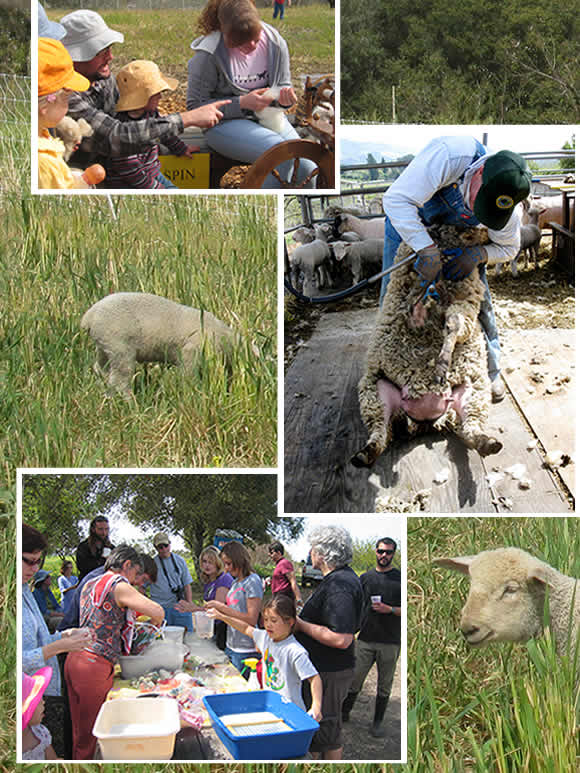
Sheep to Shawl was just the first of many more
events scheduled for the rest of the farming season. Please join us for at least one of the many awesome events
we have planned. On Tuesday, April
20th at 10:30, we begin the Wee Ones program for infants and their
caregivers again. On Saturday, May
29th we have our next Community Farm Day -- a "Three Sisters planting"
day. On Monday, April 12th
our spring farm tour season begins.
For more information on anything happening on the farm check out the
LEFDP or Live Earth Farm websites (or see the calendar below, in this newsletter). We look forward to
sharing our little piece of a sustainable food system with you! Jessica Ridgeway Director, Live Earth Farm Discovery Program
|
Spring Field Day and Wildflower Walk - Morris Grassfed Beef
~~~~~~~~~~~~~~~~~~~~~~~~~~~~~~~~~~~~~~~~~~~~~~~~ 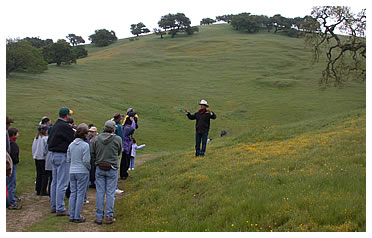 Interested in spending a beautiful spring day outdoors with your family and learning more about the land stewardship of pasture-raised beef? Our friends Joe and Julie Morris of T.O. Cattle Company invite people to come down to their ranch in San Juan Bautista (about 15 minutes south of Gilroy) on Saturday April 17th, for their annual Spring Field Day. Dedicated "grass farmer" Joe Morris will walk with you on his land, talk about his holistic management practices, and answer any questions you may have. Pack a picnic basket with drinks and dessert because after the walk, they'll be grilling Morris Grassfed Beef burgers for everyone, so you'll get to taste the results of their years of careful stewardship. You come to Live Earth Farm to see how your veggies are grown, so come on down and see for yourself how truly sustainable beef is raised. An excellent opportunity to broaden your first-name basis with the people who grow your food! Space is limited to 125 people, so be sure to RSVP (there is a nominal charge to cover the picnic supplies: $15/adult, $10/child, $40/family [2 adults, 2 children]). Click here for a pdf with more details.
|
Notes from Debbie's Kitchen~~~~~~~~~~~~~~~~~~~~~~~~~~~~~~~~~~~~~~~~~~~~~~~~ Click here to go to the recipe database.
Welcome, everybody, to the start of a new season! I especially want to welcome our new members; I've heard from so many of you that are excited to be getting your first CSA box and I want to nurture that enthusiasm. Cooking with truly spanky-fresh seasonal veggies is so transformative. People often comment about never realizing how good real fresh produce could taste. So my goal in this section of the newsletter over the season is to a) help you identify new and possibly unfamiliar veggies and b) give you plenty of good ideas as to what to do with them! If you haven't been there yet, I hope you will check out my recipe database for ideas too. And feel free to email me any time if you have questions, comments, recipe ideas, pictures or stories to share of your adventures in CSA cooking. Whatever you do though, be sure to enjoy! - DebbieCollard "rapini"Let's start with the new kid on the block, the one most of you won't know what it is: the collard greens 'rapini'. This looks like a bunch of broccoli raab - tender medium green stalks and leaves, with broccoli-like buds, maybe just a few opening into tiny yellow flowers - but it actually is the very top of our collard greens plant. This is incredibly delicious! It requires very little cooking time, and I recommend simple preparations, so as to let the flavor sing. (Of course I say this about a LOT of veggies, because when the veggies are so fresh, they have a lot of flavor all on their own. You will quickly discover this for yourself!) The collards 'rapini' can be used in any recipe you might use broccoli, broccolini, or broccoli raab, but I would recommend simply steaming the stalks whole, for maybe 2 to 3 minutes, then either serving them plain with butter and salt, or my absolutely favorite way of eating them (my fave way of eating lots of different greens, actually; you'll hear this a lot from me), is steamed to al dente, then squeezing fresh lemon juice over them, then drizzling with a flavorful olive oil - the warm veggies volatilize the oil making it fragrant and marvelous - and sprinkling with a good sea salt. That's it! Green Garlic vs LeeksTo the uninitiated, green garlic looks exactly like leeks. You will be getting both in your box this week. Tom says the leeks are larger and more mature, and so will be in the box loose, whereas the green garlic is still young and so will be bunched. But if you are ever in a situation where you're not sure which is which, trust your nose: do a "scratch-n-sniff" test - the garlic will definitely smell like garlic. Lastly, if you mix 'em up and use one in place of the other inadvertently, not to worry. They are both in the allium family and will do wonderful flavorful things to whatever you prepare - it may be a little different, but it will still be good! Something I intend to try (as an appetizer for an Easter dinner I'm attending) is to make my crispy leeks recipe, but use both leeks and green garlic! RutabagasSeems like so many people don't know what to do with rutabagas, but they are a delicious veggie. Peel and cube them, cook in boiling salted water about 10 minutes, drain and mash like potatoes with butter and salt. Sprinkle with minced fresh parsley for color and a little zing. You can also cook them together with potatoes for a potato-rutabaga mash... or with carrots for a carrot-rutabaga mash... or combine all three for a triple veggie mash! about the ApplesOur apples are the only item in your box which were not recently harvested. Apples are a seasonal crop harvested in the late summer and early fall, and then stored in controlled temperature coolers. The beauty of apples though, is that they can store so well this way, enabling us to enjoy their fruit for many months (we could never do this with strawberries!) Any apple you buy at the store would be the same. My only reason for telling you this, other than truth in advertising ;-) is because stored apples do not last as long as ones you get fresh in the fall, so 1) be sure to keep them in your refrigerator and not in a basket on your table, and 2) eat them fairly soon, i.e. don't expect to hold them in your fridge for weeks. They don't have as long a shelf-life as their younger cousins from September and October. The Fujis you are receiving this week are still sweet and good - do like I do and have one as a snack each day and they'll disappear before you know what happened! Consider, too, trying them in a green smoothie. My favorite is apple, ginger, lemon and kale. RadishesMany people do not realize that radish greens are an edible cooking green! So if the green tops of your radishes are fresh and healthy, consider saving them for a saute or wherever you might use other cooking greens like chard, kale or spinach. If I'm going to save my radish greens (I don't always, sometimes I just compost them), I cut the tops off and put them in a basin of cool water, swish 'em around good to get off any dirt or debris, then pluck them out, spin them in a salad spinner, and lay them out to air dry before bagging and refrigerating. Alternatively you can wrap them in a tea towel or paper towel when still somewhat wet from the spinner, then put them towel and all in a bag in the fridge. They'll keep for a number of days this way (but are of course fresher if used sooner!) The other eye-opener for a lot of folks is that you can cook radishes! Use them in stir-fries or sautes or soups. Here's a simple recipe for Sauteed radishes with their greens to get you going. Beet greensBeet greens, like radish greens, are also a great cooking green. I'd prepare them exactly the same way I described prepping the radish greens, above. There are a bazillion beet and beet green recipes in the database, so take a peek if you are new to this veggie! Well, I'm running out of time to cover the rest of the veggies in the box this week, but hope this will get you started! Have fun with the artichokes (yum!) and enjoy your strawberries (yum!!) and savor that kale (I love kale!!) and the sweet crispy carrots! You will never go back to eating those tasteless, bagged, whittled-down 'baby carrots' again after tasting real carrots. Cheers, and I'll talk to you next week! :-) Debbie
|
|
2010 CALENDAR
~~~~~~~~~~~~~~~~~~~~~~~~~~~~~~~~~~~~~~~~~~~~~~~~
Visit our calendar page on our website for photos and videos of past events if you would like to get the flavor of what it is like visiting the farm!
Live Earth Farm Discovery Program for WEE ONES
3rd Tuesday of every month, 10:30am - Noon
(free for children 0 - 3 yrs; $10 - $15 per adult)
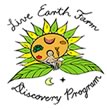 Mothers, fathers, grandparents, caretakers of any kind... bring the babe in your arms to experience the diversity of our beautiful organic farm here in Watsonville. We will use our five senses to get to know the natural world around us. The farm is home to over 50 different fruits and vegetables, chicks, chickens, goats, piglets, and the many wild members of the Pajaro watershed. Mothers, fathers, grandparents, caretakers of any kind... bring the babe in your arms to experience the diversity of our beautiful organic farm here in Watsonville. We will use our five senses to get to know the natural world around us. The farm is home to over 50 different fruits and vegetables, chicks, chickens, goats, piglets, and the many wild members of the Pajaro watershed.
For more information, contact Jessica at the LEFDP office: (831) 728-2032 or email her at lefeducation@baymoon.com.

Happy Girl Kitchen's 2010 Workshop Schedule at LEF
(all workshops are from 10am to 3pm and include an organic lunch, as well as take-home items from what is made that day!)
March 6 (Saturday) - Fermentation (sauerkraut, kimchee and kombucha)
April 10 (Saturday) - Cheese and kefir
June 6 (Sunday) - Cherries and spring berries
July 10 (Saturday) - Apricots, strawberries and blackberries
September 12 (Sunday) - Heirloom tomatoes
October 2 (Saturday) - Pickles
Contact Jordan if you have any questions
jordan@happygirlkitchen.com
http://www.happygirlkitchen.com
Community Farm Days Schedule
(All Community Farm Days are Saturdays unless otherwise noted.)
March 20 - Sheep to Shawl
May 29 - Three sisters planting in the field! Help sow pumpkins, corn, and beans
June 19 - Summer Solstice Celebration and Strawberry U-pick
July 3 - Apricot and Strawberry U-pick
July 12 thru 16 - Summer Celebration Art on the Farm Day Camp!
Aug 28 - Totally tomatoes. From farm to fork, cooking with tomatoes and making farm-fresh cheese. Also U-pick raspberry and tomato day!
Sept 25 - LEFDP Second Annual Fundraiser
Oct 23 - Harvest Celebration and Apple U-pick
Understanding Gluten Sensitivity - Lecture and Cooking Class
Saturday May 1st, 11am - 4pm, on the farm (in the farm barn kitchen)
click here for more info
|
|